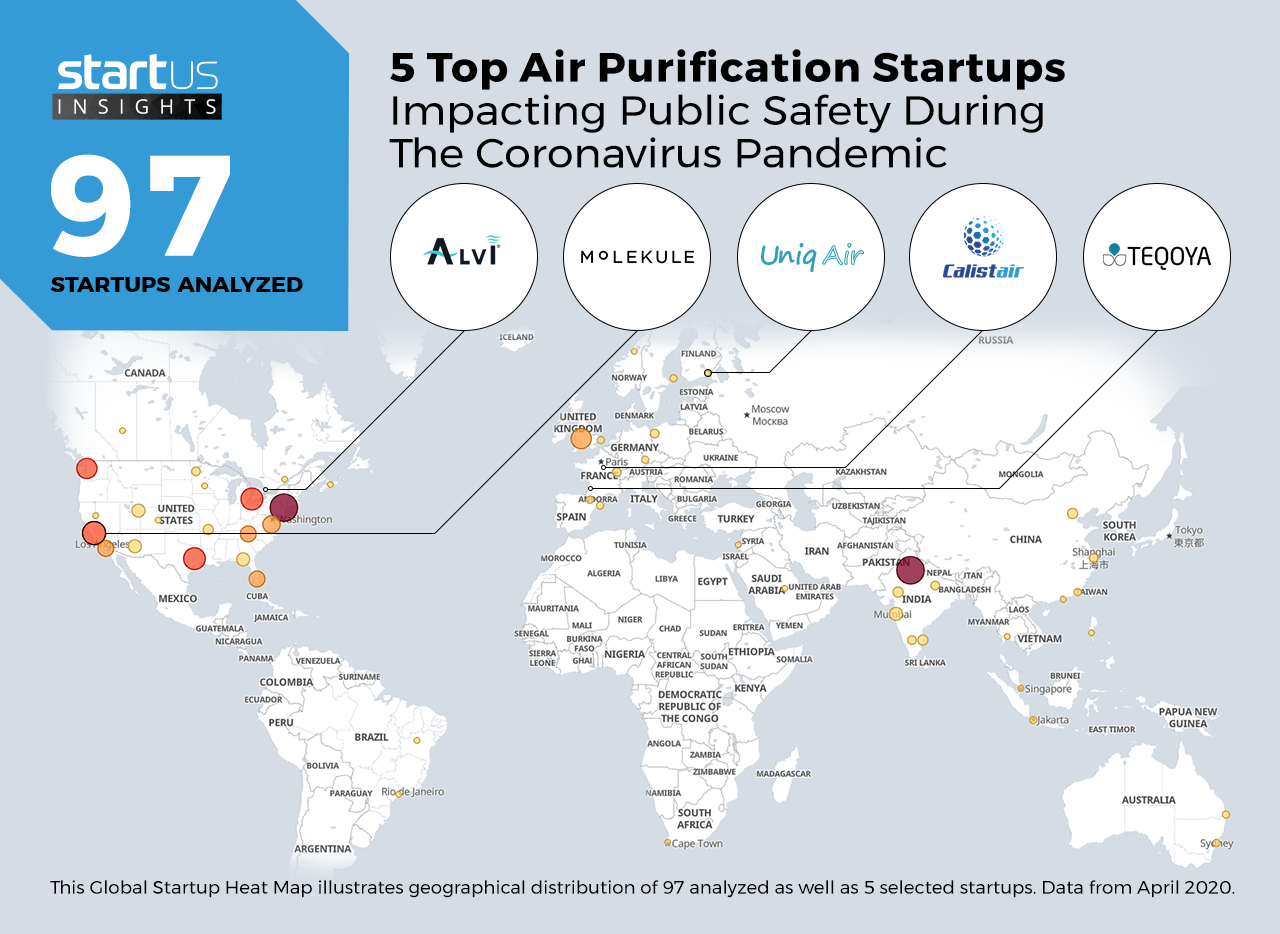Our Innovation Analysts recently looked into emerging solutions that mitigate the effects of the Coronavirus epidemic. Here, we are taking a look at some of the top air purification startups.
Heat Map: 5 Top Air Purification Solutions
For our 5 top picks, we used a data-driven startup scouting approach to identify the most relevant solutions globally. The Global Startup Heat Map below highlights 5 interesting examples out of 97 relevant solutions. Depending on your specific needs, your top picks might look entirely different.
CleanAir – Active Polarization
Active polarization filters use an active electrostatic field to polarize both the fibers of a media pad and the particles to be removed. This minimizes energy loss relative to that in conventional filter-based air purification systems and leads to more effective air purification.
Canada-based startup CleanAir offers the ALVI SMART Air Purifier, based on active polarization technology. Polarized fields bind dust together and the system then filters it out, leading to lower energy consumption. The ALVI system removes bacteria, germs, and airborne viruses down to the 0.007-micron range.
TEQOYA – Air Ionizers
Air ionizers use ions to remove dust, microbes, and odors from the air. Negative ions produced in nature are responsible for pure air in several parts of the earth. Ionizers work based on the basic principles of attraction between oppositely charged particles. However, many air ionizers emit harmful ozone, and innovations are underway to eliminate it from the process.
French startup TEQOYA develops air purifiers that diffuse negative ions to purify the air. The stream of negative ions from the purifier neutralizes and settles down the pollutants while the ozone-free kinetic process also has a germicidal effect on bacteria and viruses.
Molekule – Photoelectrochemical Oxidation (PECO)
High-efficiency particulate air (HEPA) filters are among the most common air purification filters. However, HEPA filters simply trap the contaminants which can inadvertently promote the growth of harmful microbes. An effective air purification system needs to destroy the harmful microbes and viruses such as coronaviruses to make indoor air pure and safe.
The US-based startup Molekule builds a proprietary photoelectrochemical oxidation technology to destroy air pollutants and microbes at the molecular level. Free radicals produced upon light-induced activation of nanocatalysts present on the fibers of PECO-filter are used to break down viruses, bacteria, mold, volatile organic compounds, and allergens.
Calistair – Non-Thermal Catalysis
The light-activated catalysis process is a common air purification method. The catalysts do not operate at ambient temperature and need to be activated by ultraviolet light (UV). The right combination of absorbent material and catalysts completely decontaminates the air as it traps and destroys microbiological and chemical contaminants.
Calistair is a France-based startup working on an air purification system based on proprietary athermal catalysis technology. The R4000 is a mobile autonomous air decontamination unit suitable for hospitals and clean room facilities. The unit uses non-thermal catalysis with an adsorbent and two catalysts to efficiently purify the air. One of the catalysts is light-activated, whereas the other works at ambient temperature.
UniqAir – Activated Carbon
Air filtration systems employ different types of filters, including electric filters which produce harmful compounds such as ozone. However, simpler air filters that lack harmful UV lamps and do not produce ozone drastically do not filter out viruses such as the coronavirus. New adsorbents – for example, activated carbon – address this issue.
Finland-based company UniqAir manufactures activated carbon filter air purifiers. The Activated Carbon Titanium Air Purifier has a separation rate greater than 99% in the 0.1-micrometer range. These ozone-free filters remove bacteria and viruses including coronaviruses and find applications in healthcare facilities.
How To Flatten The Curve?
This is an unprecedented situation for many of us across the world. The SARS outbreak in the early 2000s claimed 774 lives. That toll was enough to drive research & development and easier healthcare solutions. It is an encouraging fact that several mobile health, e-health, diagnostics, and remote health startups and emerging companies are able to respond during a pandemic. With thousands of deaths already, we expect to see numerous new companies offering technology-driven solutions to help doctors, nurses, other health workers, and the larger public.










